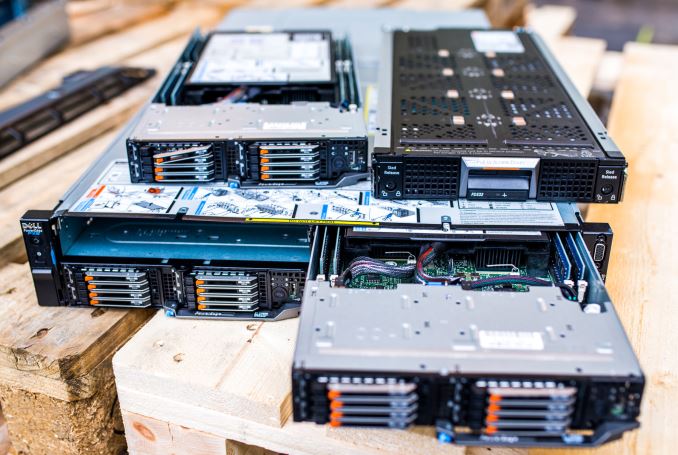The Evolution of HDDs in the Near Future: Speaking with Seagate CTO, Mark Re
by Anton Shilov on July 6, 2016 2:00 PM ESTNew 10K and 15K RPM HDDs Incoming
Hard drives with 10K and 15K spindle speeds are used to store mission-critical applications and data that also require high performance. Such drives typically use a SAS interface with its advantages over SATA/AHCI. Plenty of legacy systems and setups still rely on these fast hard drives, and as a result these systems are not going to be decommissioned in the near future. Nonetheless, the total available market for ultra-fast HDDs with 10K and 15K RPM spindle speeds has shrunk in the recent years due of SSDs. This does not mean that speedy HDDs no longer evolve - Seagate informed us that it is preparing another generation of 10K and 15K RPM HDDs.
Seagate’s new generation of 10K hard drives will not only feature 10K RPM spindle speed as per the name, but also TDMR technology — two readers per head. Those readers will read one track to improve signal to noise ratio and enable higher capacities. Keeping in mind that we are talking about critical storage applications, HDDs with two readers per arm will keep using PMR or SMR recording technology, but eventually the tech could be used for HAMR-based drives.
When it comes to 15K HDDs, Seagate seems to be somewhat more humble or secretive. The company did confirm that it is working on at least one more generation of 15K hard drives. The high-performance SAS deployments are already there and someone needs to serve them, which is where the next-generation 15K HDDs may come in handy. Moreover, SNIA has a long roadmap for SAS towards 24 Gb/s transfer speeds and the year 2020 ahead of it, which is why it is important for Seagate to offer both HDD and SSD solutions for this market. The next generation of 15K HDDs could be the last generation of such hard drives, which is why it will have to offer a balance of features and technologies that Seagate does not want to discuss at this time. Perhaps, not because of competitive reasons, but because it is working with its customers to enable features that they need.
Nonetheless, as new data center platforms arrive, the need for 15K HDDs will inevitably decrease and Seagate understands that. For example, Intel’s latest SSDs for mission-critical applications rely on PCIe bus and NVMe protocol. As a major provider of ultra-high-end Nytro storage accelerators, Seagate will naturally follow market’s trends, but this is a topic to be covered by an SSD-related conversation.











91 Comments
View All Comments
abrowne1993 - Wednesday, July 6, 2016 - link
Is that all for one second of CGI in the new Transformers movie?Michael Bay - Thursday, July 7, 2016 - link
And some porn.Holliday75 - Friday, July 8, 2016 - link
Is Megan Fox back? She could probably use the cash.JlHADJOE - Monday, July 11, 2016 - link
8 Terra bits? So 1TB =)wumpus - Thursday, July 7, 2016 - link
@JoeyJoJo123>It's ogre. HDDs are dead. SSDs won.
>Just give up.
Know how I know your data isn't backed up? There are two types of people. Those who have lost all their data, and those who are going to (possibly again).
Sure, you might not know how Amazon is storing your data, but I'll bet that it just isn't backed up.
Hard drives just moved up the data hierarchy. They are now stuck between tape (near the cost/TB without the huge entry costs) and SSD. They are also still ideal for NAS, especially consumer grade to fairly decent grade. Don't forget all the random access advantages HDDs have over tape.
I also expect to watch the whole HDD/SSD dance play over again with SDD/3dxpoint. Although the more interesting story will be if 3dxpoint will be able to replace main/virtual memory, leaving multi-GB DRAM "caches" between the CPU and "main memory".
Perhaps Mr. Ogre needs to consult with the tri-lambs. I'm sure they could find some uses for HDDs.
Nagorak - Monday, July 11, 2016 - link
I'm having difficulty understanding your comment but if you're implying that data stored on AWS isn't backed up then I find that almost inconceivable.hectorsm - Thursday, July 7, 2016 - link
You're delusional. Today ~99% of PC shipments still have HDDs.romrunning - Wednesday, July 6, 2016 - link
SMR was never a technology that ever interested me. I don't want more storage with measurably worse performance than existing ones. Seagate should have invested more into SSD tech than in SMR for HDDs.JoeyJoJo123 - Wednesday, July 6, 2016 - link
You can do both. SMR for the platters with additional flash cache for frequently accessed data. Unfortunately HDDs are a one trick pony now, and they need to push in the one area they're better than SSDs in (relative amount of storage per $ spent).extide - Thursday, July 7, 2016 - link
Yeah I always thought the combo of a SMR drive + some NAND cache was like super obvious, and I am wondering why we haven't seen more drives like that.